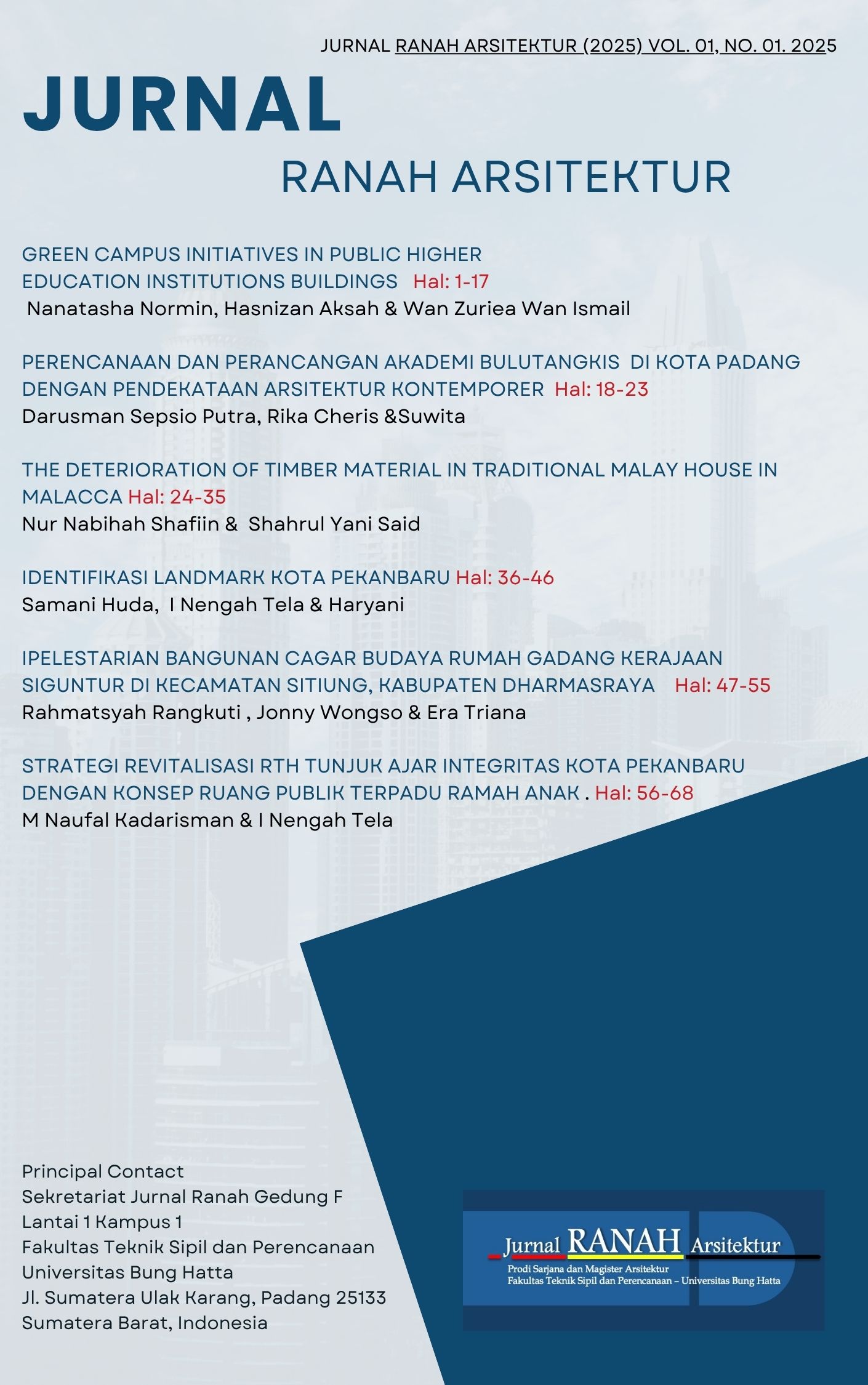GREEN CAMPUS INITIATIVES IN PUBLIC HIGHER EDUCATION INSTITUTIONS BUILDINGS
Keywords:
Higher Education Institutions, Green Campus Initiatives, Sustainability, UI GreenMetricAbstract
Malaysia is indeed growing the number of sustainable building projects across the country. For Higher Educational Institution (HEI) buildings, there are a few universities in Malaysia currently implementing green campus. On the other hand, the initiatives of green campus have few issues, including environment, economic, and social aspects. This study aims to highlight the green campus initiatives in HEI buildings. Data was collected through interviews and site observations on the case studies specifically at Universiti Teknologi Mara, Shah Alam, Universiti Malaya and Universiti Putra Malaysia, Serdang. The findings reveal the most initiatives that have been adopted by HEI are solar panels, sustainable transportation, and energy-efficient building designs. However, constraints such as limited finance, aging infrastructure, and community attitudes hinder progress. The study contributes to academic research on sustainable campus management by making strategic recommendations, such as improving stakeholder relationships, enhancing awareness campaigns, and utilizing smart energy systems. By addressing these concerns, the study aims to help Malaysian public HEI achieve sustainability objectives and enhance the country’s commitment to global environmental goals.
REFERENCES
Aris, A.Z., Ishak, M. Y., Zamaruddin, N. H., & Ponrahono, Z. (2018). Green@Universiti Putra
Malaysia: Cultivating the Green Campus Culture, E3S Wed of Conferences, 48, 1-5.
Algburi, S. M., Abdul Aziz, F., & Baharudin, B. T. H. T. (2016). Review of Green Building
Index in Malaysia; Existing Work and Challenges, MALRep, 11(5), 2-11.
Asmawi, A., & Mohd Jaladin, R. A. (2018). Higher Education System in Malaysia: Exploring
Strategic Trends and Challenges in Policy Implementation for New Malaysia, 6(4), 56–77.
CIDB. (2023). Green buildings in Malaysia: Increasing Demands for Sustainable Practices.
de Paula, N., Jyo, L. K., & Melhado, S. B. (2022). Sources of Challenges for Sustainability in
the Building Design: The Relationship Between Designers and Clients, MDPI, 12(10), 114.
Hooi,
K. K., Hassan, F., & Che, M. M. (2012). (PDF) The Impact of Sustainable Higher
Education Building Spaces Design: An Exploratory Study of Readiness and Development
of Green University Framework in Malaysia, 50, 525-536.
Huovila, P., & Koskela, L. J. (2014). Contribution of the Principles of Lean Construction to
Meet the Challenges of Sustainable Development: 6
Annual Conference of the
International Group for Lean Construction, 225, 2-10.
th
Isa, H. M. (2023). Green Campus Implementation in the Malaysian Public Universities:
Challenges and Solutions. Planning Malaysia, 12(1), 274-298.
Islam, M. R., Saidur, R., Rahim, N. A., & Solang, K. H. (2010, June). Usage of Solar Energy
and Its Status in Malaysia – um: Usage of Solar Energy and Its Status in Malaysia, 5(1), 610.
Lam,
W. H., Wong, C. F., Tan, O. K., & Yap, B. H. (2024). Study on the Benefits of the
Implementation of Green Building Rating in Malaysia: The Journal of The Institution of
Engineers Malaysia, 85(1), 17-24.
Laws of Malaysia. (2012). Act 549: Standards Of Malaysia Act 1996.
Malaysian Standard. (2007). MS 1525: Code of Practice on Energy Efficiency and Use of
Renewable Energy for Non-Residential Buildings (First Revision).
Massarotto, A. (2021). What’s The Difference Between Green and Sustainable Buildings?
Moglia, M., Cook, S., & McGregor, J. (2017). A review of agent- based modelling of technology
diffusion with special reference to residential energy efficiency: Sustainable Cities and
Society, 11(5), 2-9.
Ochoa, J., Aranda-Mena, G., & McGinley, T. (2016). (PDF) The Impact of Sustainable Higher
Education Building Spaces Design. The Impact of Sustainable Higher Education Building
Spaces Design on Staff and Students’ Experience, 1, 398-407.
Paula, G. S., de Moura, J. M., de Almeida, M. R., & de Rezende, J. F. D. (2022). Sustainable
development goals in higher education institutions: A systematic literature review. Journal
of Cleaner Production, 370, 221-235.
Shafique, M., Reeho, K., & Rafiq, M. (2018). Green Roof Benefits, Opportunities and
Challenges - A Review. Renewable and Sustainable Energy Reviews, 90, 757-773.
Stough, T., Ceulemans, K., Lambrechts, W., & Cappuyns, V. (2017). Assessing sustainability in
higher education curricula: A critical reflection on validity issues. Journal of Cleaner
Production, 172, 4456-4466.
Suganthi, S. H., Murshid, S., Sriram, S., & Ramani, K. (2018). Enhanced Biodegradation of
Hydrocarbons in Petroleum Tank Bottom Oil Sludge and Characterization of Biocatalysts
and Biosurfactants. Journal of Environmental Management, 220, 87-95.
Sugiarto, A., Lee, C.-W., & Huruta, A. D. (2022). A Systematic Review of The Sustainable
Campus Concept. MDPI, 12(5), 2-11.
Wald, N., Harland, T., & Daskon, C. (2023). Open Access. The gap statement and justification
in higher education research: An Analysis of Published Articles. Getting Started with
Research: A Guide to Research Methodology, 14(2), 308-323.






